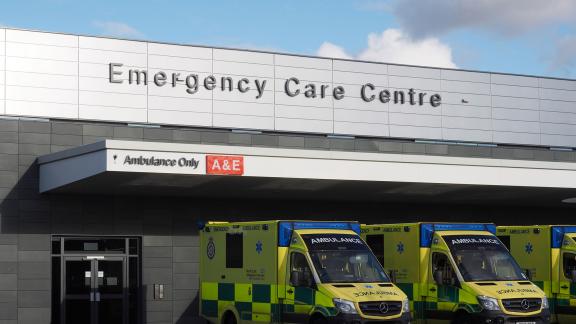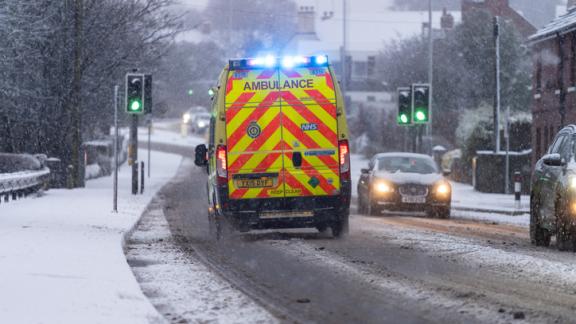NHS Wales system pressures

Introduction
While COVID-19 admissions and deaths are currently relatively low, the NHS in Wales is experiencing an extreme surge in demand for other services as it responds to the current phase of the COVID-19 pandemic. Health Boards and NHS Trusts continue to respond to the challenges of managing the COVID-19 virus with a growing backlog of planned care and increasing demand for urgent care.
There’s no single reason for the current situation, but a multitude of complex factors across the whole health and care system. In many areas we’re seeing the highest levels of demand ever, combined with restricted capacity, increasing patient needs and high public expectation, culminating in the greatest pressure on the NHS in a generation.
This briefing outlines the views of NHS leaders on the factors driving this heightened period of demand.
Key messages
- The NHS is having to respond to a significant backlog of planned care.
- Increases in non-COVID activity, as well as increased acuity in patients, are resulting in system-wide pressures, in particular across primary care, the ambulance service, Emergency Departments and mental health services.
- Managing the ongoing threat from COVID-19 requires frontline services to operate with much reduced capacity due to the need for infection prevention and control measures.
- The workforce has been under continued pressure, with sickness absence, stress, well-earned annual leave and the need to self-isolate compounding the current situation.
- Public expectations do not reflect the current capacity limitation and restrictions on the NHS as more is being demanded of it.
- Pressures are being felt across both health and social care and a holistic approach is required to ensure challenges are effectively dealt with.
- The rapidly rising demand for urgent and emergency care threatens to slow down NHS leaders’ attempts to recover the elective care backlog, however NHS organisations continue to use innovative measures to manage demand.
- NHS leaders urge the public to use services appropriate to their needs, using the NHS 111 website and online symptom checker and pharmacies where they can reduce demand on ambulance services and Emergency Departments.
Statistics: NHS activity
- In June 2021, over 41,000 emergency calls were made to the ambulance service. This is the third highest average number of calls per day in any month since comparable data was first collected in October 2015.
- In June 2021, the proportion of all calls that were immediately life-threatening (red calls) was 7.9%. This is the highest monthly percentage of red calls since comparable red call data was first available in May 2019.
- In June, there were over 94,000 attendances to all NHS Wales Emergency Departments, surpassing pre-pandemic levels, with the average number of attendances per day being the second highest on record.
- The COVID-19 pandemic has impacted on the total number of patient pathways waiting to start treatment, with the number increasing steadily every month since May 2020, reaching just over 608,000 by the end of May 2021.This is the highest since comparable data was first collected in 2011.
Pressure points
Managing the ongoing threat of COVID-19
Unsurprisingly, COVID-19 is continuing to impact NHS capacity to support patients. The need for ongoing infection prevention and control (IPC) measures within NHS sites and care settings has become part of daily business, reducing the number of patients that can safely be treated each day, both because of time and physical capacity needed to maintain social distancing. For example, emergency response teams are required to complete additional procedures, including wearing extra personal protective equipment, impacting the speed at which they can respond to a call. After an ambulance has been dispatched to the scene, it must then go through additional cleaning processes to prevent the spread of the virus, resulting in the vehicle being taken off the road for a time which may also affect response times during this period. It remains NHS priority to keep staff and patients safe and as we know, even with high standards of IPC, transmission can still occur.
Workforce
NHS organisations are reporting higher sickness levels, with the three highest causes of sickness relating to psychological issues, COVID-19/ long COVID and stress. Many staff, particularly those with school-aged children, are self-isolating due to potential close contact with the virus. It is also the peak of summer leave, with many staff taking extra leave that was postponed to enable the NHS to cope with previous waves of COVID. The retention of the current workforce and recruitment of new staff has posed significant problems for the NHS in Wales for some time and NHS leaders recognise the challenges faced by the NHS workforce. NHS staff health and wellbeing continues to be the priority. Our recent briefing, Supporting Welsh NHS staff wellbeing throughout COVID-19, showcases some of the initiatives that have been introduced across NHS Wales to support staff health and wellbeing during the pandemic.
Urgent and emergency care
The most emblematic symbol of escalating demand for NHS services is the image of ambulances queueing outside an Emergency Department ‘front door’. This has become an increasing feature in recent weeks as Health Boards and NHS Trusts have experienced record-breaking demand on ambulance services and Emergency Departments, with reports of long waits and handover delays across Wales. The impact of lockdowns and the public reluctance to access healthcare (so as not to increase demand on services) are linked to increased demand in cardiology, slips, trips, falls and non-trauma emergency surgery.
Primary care
This rise in demand is having a significant impact on primary care, consequently impacting all parts of the urgent care system. Primary care services are combining face-to-face and virtual consultations to respond to the increasing demand. Primary care is implementing these strategies in the context of workforce challenges, increased demand for less severe COVID-19 related issues, post-lockdown impact of services being paused and late presentation of patients.
Mental health
The pandemic has affected the population and staff in different ways but demand for mental health services is a key concern, especially in children and young people. Not only are more patients seeking mental health support, but many are presenting with more advanced issues, often putting pressure on emergency and community services, and other sectors like the police. Mental health services continue to plan and deliver support to populations across the various tiers of the service in response to the increasing prevalence of mental health issues.
Cancer
Velindre Cancer Centre is experiencing a 25% reduced capacity in radiotherapy due to required infection control. Referrals are exceeding pre-COVID levels but this varies across tumour sites. Velindre is managing a 20% increase in systemic anti-cancer therapies referrals above pre-COVID levels through increased capacity. Waiting times have been maintained through a combination of a reduction in radiotherapy referrals and changes in practice.
Welsh Blood Service
Social distancing has impeded blood collection capacity across Wales, placing constraints on the service to meet demand. To date, the Welsh Blood Service has been fortunate enough to sustain hospital supply. However, the service lacks the ability to flex its collections to keep pace as hospital activity returns to pre-COVID demand. A range of options are being explored, including the establishment of a new fourth south Wales collection team who will be operational in September.
Social care
The NHS does not work in isolation and issues of capacity and workforce in adult social care and children services are having serious implications, including the inability to discharge large numbers of medically fit patients from hospital. A collective approach to many of these issues is essential. NHS leaders are undertaking significant work with local authority partners to minimise disruption, but the long-standing issues within the care sector further strengthen the existing calls for Governments across the UK to support integration between health and care and create a sustainable financial model for the sector.
Population health and wellbeing
Early indications show that challenges facing the population following a period of lockdown and restrictions will contribute to deterioration in population health and increase inequalities across communities. Recent research funded by Public Health Wales highlights how vulnerability emerged as a direct result of COVID-19 and the restrictions put in place. This has taken the form of worsened mental health due to anxiety and loneliness, economic insecurity due to strained household finances and job losses, digital exclusion and a loss of many face-to-face services. All health bodies have programmes planned to address the role that the NHS can play in mitigating against the compounding effect COVID-19 will have on population health and wellbeing, inequalities, socio-economic status and fiscal stability.
Expectation
Public expectation has changed throughout the pandemic and people are understandably less tolerant and expect a speed of recovery the NHS is currently unable to deliver. When COVID rates were high, it was easy to understand the ‘what’ and the ‘why’ of pressures on services. But as we hear of impressive vaccination rates and the subsequent effect on hospitalisations, it’s hard for the public to understand why the NHS isn’t recovering all services at pace. Public feedback is indicating an expectation and desire for many services to return to “pre-pandemic normal”, especially around face-to-face contact, and to be seen quickly after long-awaited appointments following delays during the pandemic. The combination of factors means that the speed of elective recovery isn’t going to be what NHS leaders would like it to be.
Good practice
NHS leaders know that thousands of patients have been waiting for months for treatment or surgery, and work is constantly being undertaken to ensure patients are kept well-informed and supported while they wait. It’s important to stress that although there is pressure on services across the system, many are coping. This is, in part, thanks to inspiring innovations and transformation in services resulting from the pandemic and the hard work and commitment of amazing staff.
NHS organisations are working tirelessly to tackle the pressures within their area. New pathways and protocols are being delivered to restart planned care services, new ways of working are being deployed to manage high demand and learning is being taken forward to prevent infection. Examples of service transformation can be found in our latest Good Practice Briefing. There’s much to learn from the innovation that has taken place, and harnessing the speed and agility of service adaptation is something that must contribute to future work.
Forward look
We know that severe pressures are being felt across the entirety of health and social care, therefore a whole-system approach is required to meet these challenges so we can provide the care and treatment needed.
There is no evidence to suggest the pressures will reduce over the coming months. Welsh Government modelling for Coronavirus admissions, supported by local modelling approaches, suggest this will increase significantly as we enter the winter period. Plans are being developed but we are currently anticipating workforce being the fundamental constraint to successfully meeting this demand.
NHS leaders will do all they can to provide the best possible care to all, but improving the current situation is not something we can do alone. We need a clear multi-year financial settlement from Governments so we can plan and transform recovery and we urgently need the public to continue to help the NHS by using services appropriate to their needs where and when they can. This means using the NHS 111 Wales website and online symptom checker and resources such as community pharmacies wherever possible.



